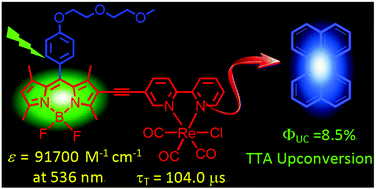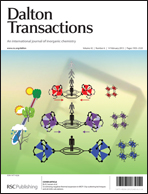We prepared N^N Re(I) tricarbonyl chloride complexes (Re-1 and Re-2) that give very strong absorption of visible light. To this end, it is for the first time that boron dipyrimethane (Bodipy) was used to prepare Re(I) tricarbonyl chloride complexes. The π-conjugation linker between the π-conjugation framework of the antenna Bodipy and the Re(I) coordination centre ensures efficient intersystem crossing (ISC). Re-0 without visible light-harvesting ligand was prepared as a model complex in the photophysical studies. Re-1 (with Bodipy) and Re-2 (with carbazole-ethynyl Bodipy) show unprecedented strong absorption of visible light at 536 nm (ε = 91 700 M−1 cm−1) and 574 nm (ε = 64 600 M−1 cm−1), respectively. Interestingly, different from Re-0, Re-1 and Re-2 show fluorescence of the ligand, not the phosphorescence of the Re(I) coordination centre. However, long-lived triplet excited states were observed upon visible light excitation (τT = 104.0 μs for Re-1; τT = 127.2 μs for Re-2) vs. the short lifetime of Re-0 (τT = 26 ns). With nanosecond time-resolved transient absorption spectroscopy and DFT calculations, we proved that the triplet excited states of Re-1 and Re-2 are localized on the Bodipy ligands. The complexes were used as triplet photosensitizers for two triplet–triplet-energy-transfer (TTET) processes, i.e.1O2 mediated photooxidation and triplet–triplet annihilation (TTA) upconversion. With the strong visible light-harvesting ability, Re-1 proved to be a better 1O2 photosensitizer than the conventional triplet photosensitizer tetraphenylporphyrin (TPP). Significant upconversion was observed with Re-1 as the triplet photosensitizer. Our result is useful for preparation of Re(I) tricarbonyl chloride complexes that show strong absorption of visible light and long-lived triplet excited states and for the application of these complexes as triplet photosensitizers in photocatalysis, photodynamic therapy and TTA upconversion.

You have access to this article
 Please wait while we load your content...
Something went wrong. Try again?
Please wait while we load your content...
Something went wrong. Try again?


 Please wait while we load your content...
Please wait while we load your content...